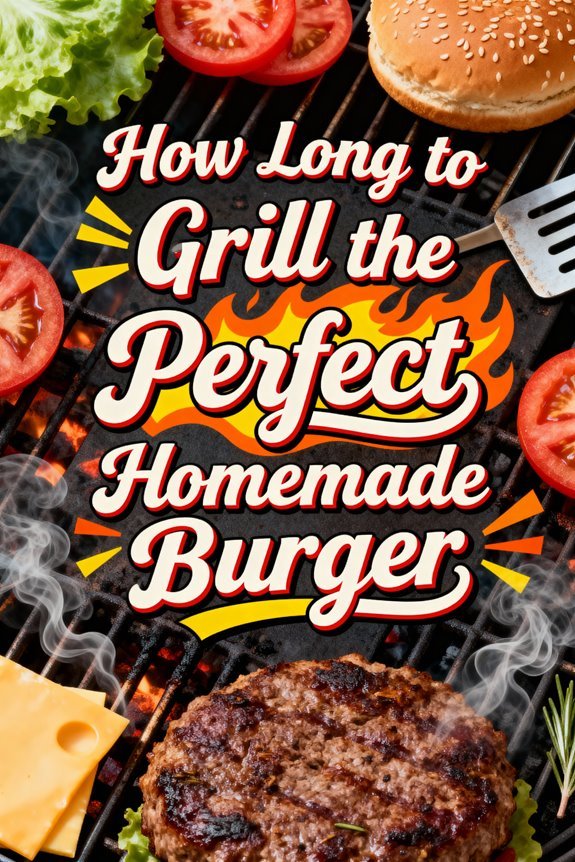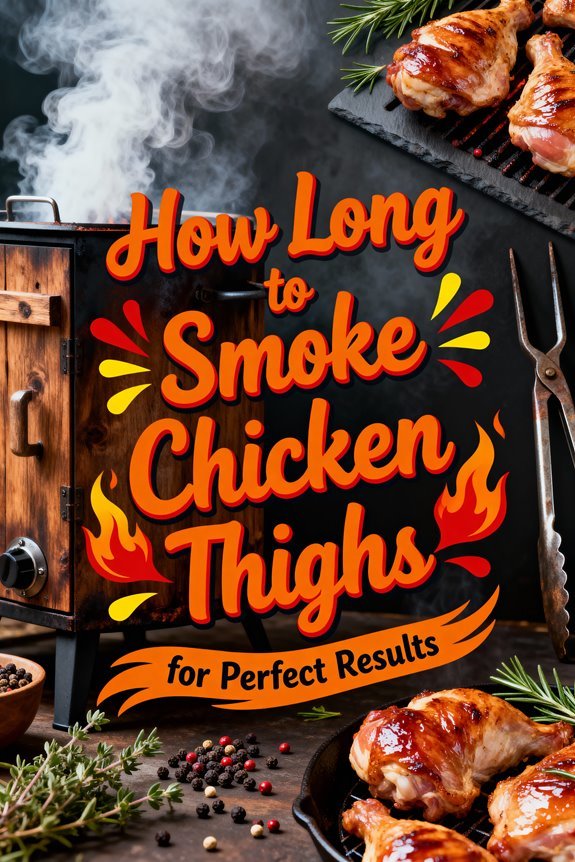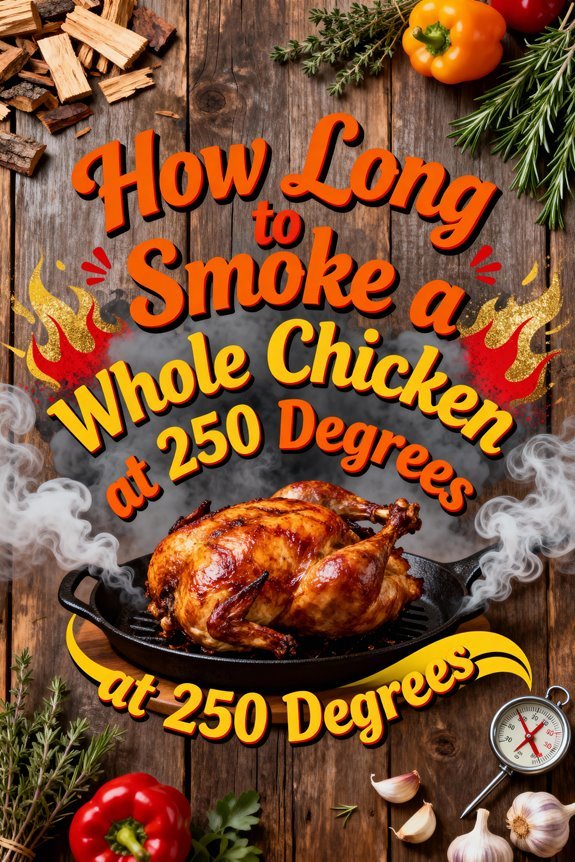You’ll need 1.5 to 3 hours to smoke chicken breasts at 225°F to 250°F, but thickness matters more than time. Always pull your chicken when it hits 160°F internally—it’ll climb to a safe 165°F during the 10-minute rest. Use a dual probe thermometer for accuracy, and stick with milder woods like apple or cherry to avoid overpowering the meat. The guide below covers two-stage smoking techniques, brining strategies, and storage methods that’ll transform your results.
Ideal Smoker Temperature for Chicken Breasts
Setting up your smoker between 225°F and 250°F delivers the most reliable results for chicken breasts, giving smoke adequate time to penetrate the meat while keeping moisture intact. This range maximizes flavor profile development with fruitwoods like cherry or apple without risking dryness. You can push smoker temperature to 300°F for faster cooking—around 60 minutes total—but you’ll need vigilant monitoring to prevent overcooking. Lower temperatures allow smoke compounds to infuse gradually, producing richer taste. For enhanced texture, start at 225°F until internal temperature reaches 115°F, then raise heat to 375°F to finish. A pellet grill provides a light smoky flavor that works well for beginners. Always preheat your smoker to your target temperature before adding meat, ensuring consistent heat distribution. Similar to dry rub preparation for turkey breast, season your chicken thoroughly before smoking. Use a leave-in thermometer for precision throughout the cook. Consider spraying with apple cider vinegar during smoking to maintain moisture and add subtle tang.
Target Internal Temperature for Safety and Juiciness
While smoker temperature sets the stage, your chicken’s internal temperature determines both safety and eating quality. Pull your smoked chicken breasts at 165°F—the USDA’s mandated threshold for eliminating Salmonella and Campylobacter. However, understanding the juiciness balance reveals more nuance: holding chicken at 155°F for one minute achieves equivalent safety while retaining more moisture. Temperature variation between white and dark meat matters—breasts benefit from lower temperatures to prevent drying, while thighs tolerate higher heat for ideal tenderness. Use a precise digital thermometer inserted into the thickest part, avoiding bone contact. Account for carryover cooking during rest; internal temperature typically rises 5°F post-smoke. Wet brining your chicken breasts before smoking improves moisture retention and enhances flavor throughout the meat. For optimal skin texture, consider raising smoker temperature to 375-400°F during the final 10-15 minutes of cooking. Low temperature smoking at 225°F allows deep flavor development over 1-2 hours. This precision transforms acceptable chicken into exceptional results, marrying food safety with superior texture and flavor.
Estimated Cooking Times at Different Temperatures
Understanding smoker temperature alone won’t guarantee perfectly cooked chicken—you must factor in time estimations to plan your cook effectively. At 225°F, boneless chicken breasts typically require 2–3 hours to reach the safe internal threshold of 165°F, though this extended timeline rewards you with maximum moisture retention. Increase your smoker to 250°F, and you’ll cut that window to 1.5–2 hours while maintaining excellent juiciness—a sweet spot many pitmasters prefer for balancing efficiency with quality. Push to 275°F, and you’re looking at roughly 1 hour of smoking time, though this accelerated pace demands vigilant thermometer monitoring to prevent dryness. These estimates assume proper brining methods and seasoning tips have been applied beforehand. Remember: breast thickness dramatically impacts these timeframes, so always prioritize internal temperature over clock-watching. Use a dual probe thermometer to simultaneously monitor both your chicken’s internal temperature and your smoker’s ambient heat, ensuring you maintain consistent cooking conditions throughout the process. Adding fruitwood chips like cherry or apple will infuse your chicken with delicate, sweet smoke flavors that complement the meat perfectly. Like smoking beef jerky, maintaining thin blue smoke instead of thick white smoke helps prevent bitter flavors from developing in your chicken.
Essential Preparation Steps Before Smoking
Apply effective seasoning techniques by lightly coating with oil, then applying your dry rub evenly across all surfaces. Similar to grilling tenders at medium-high heat, maintaining proper temperature control is essential for even cooking. For optimal tenderness like bone-in thighs, aim for an internal temperature range between 165°F to 195°F. Refrigerate for at least one hour to allow seasoning penetration. Keep chicken cold until you’re ready to smoke, maintaining food safety while preserving quality. If you choose to brine, submerge the chicken in a solution of Kosher salt and sugar for up to 4 hours before smoking to enhance juiciness.
Choosing the Right Wood for Chicken
The wood you select fundamentally shapes your chicken’s flavor profile, making this decision as critical as your temperature control or timing. For chicken breasts specifically, you’ll want milder woods like apple or cherry that won’t overpower the delicate white meat. Apple delivers subtle sweetness, while cherry adds gentle smoke with appealing color. Like smoking ham at low cooking temperatures, consistent smoke output ensures even flavor development.
Wood combinations offer enhanced complexity—try apple with pecan for fruity-nutty balance, or cherry with maple for layered sweetness. Avoid hickory unless you’re seeking bold intensity, as it can dominate chicken’s natural flavor. Use seasoned wood chunks for steady smoke output, and exercise restraint with quantity. Too much smoke creates bitterness rather than enhancing flavor balance. While hickory and mesquite create robust smoke flavor ideal for beef ribs, they’re typically too strong for poultry. Start with single woods before experimenting with blends. Pecan wood provides a mild nutty flavor that enhances chicken’s natural taste without overpowering it.
How to Check Doneness Accurately
When should you actually check your chicken’s temperature—and where exactly should that thermometer probe go? Insert your probe into the thickest part of the breast, avoiding bone contact that’ll skew readings. Start checking temperatures around the 45-minute mark at 225°F, or at 35 minutes when smoking at 300°F. You’re targeting 165°F for USDA-approved safety, though pulling at 160°F works if you account for carryover cooking—those extra 3-5 degrees that’ll accumulate during rest. Much like achieving low and slow perfection when grilling sandwiches, patience is key for properly cooked chicken. While visual doneness indicators like clear juices and firm texture exist, they’re unreliable compared to actual temperature readings. Use a quality meat thermometer—preferably wireless—to monitor progress without constantly opening your smoker. For even greater precision, consider using a leave-in probe thermometer that continuously tracks your chicken’s internal temperature throughout the smoking process. Temperature accuracy trumps guesswork every time when achieving perfectly cooked, juicy chicken breasts. Similar to grilling ribs, a 15-minute rest after cooking helps lock in the meat’s natural juices.
Resting and Carryover Cooking Explained
Patience separates novice grillers from pitmasters who consistently deliver juicy, perfectly-cooked chicken breasts. After smoking, you must rest your chicken for 10 minutes to allow juice redistribution throughout the meat. During this period, carryover temperature raises internal heat by 5-10°F, meaning you’ll pull breasts at 160°F and let them coast to the USDA-recommended 165°F.
Much like a low and slow approach used for brisket smoking, proper rest timing is crucial for optimal results. Just as seasonal sales help optimize grill purchases, proper timing is essential for perfect results. Proper resting techniques involve loosely tenting chicken with aluminum foil to preserve warmth without trapping steam. Monitor the carryover temperature with an instant-read thermometer to confirm it reaches safe levels. Breasts rested under 5 minutes lose excessive juice when sliced, while resting beyond 15 minutes causes unnecessary cooling. Pour any accumulated buttery juices from the butcher paper over the sliced meat for enhanced flavor and moisture. Reserve accumulated juices and drizzle over sliced meat for enhanced flavor and moisture.
Common Smoking Mistakes to Avoid
Even experienced pitmasters fall victim to preventable errors that transform potentially succulent chicken breasts into dry, disappointing disappointments. Common smoking mistakes include temperature mismanagement—running your smoker below 225°F extends cooking time unnecessarily, while exceeding 250°F creates tough, uneven results. You’ll sabotage moisture retention by skipping brines or neglecting periodic basting during the smoke. Poor seasoning techniques matter too: insufficient salt fails to enhance protein structure, while over-salting draws moisture out prematurely. Opening your smoker frequently releases critical heat and smoke, prolonging cook times. Most critically, overshooting the 155-160°F internal temperature threshold guarantees dryness. Relying on single-point probes misleads you about actual doneness. Finally, failing to wrap and rest your chicken post-smoking accelerates moisture evaporation, undoing your careful work. Just as a deep cleaning routine helps maintain your grill’s performance, proper smoking technique preserves the quality of your meats. Wrapping at the wrong stage compromises texture—wait until the chicken reaches 120-125°F before wrapping to preserve both moisture and bark development. Similar to grilling burgers, allowing meat to rest for 5 minutes after cooking helps redistribute the internal juices for optimal results.
Two-Stage Smoking for Crispy Skin
You’ve avoided the major pitfalls—now master the two-stage smoking method that delivers what most backyard smokers struggle to achieve: genuinely crispy skin alongside moist, smoke-infused meat.
Start at 225°F for 40-60 minutes until your chicken reaches 120-125°F internally. Wrap in butcher paper with butter pads, then return to the smoker at 250°F. This two-stage approach prevents moisture loss while developing flavor complexity. Wood choices like oak work especially well for achieving balanced smoky flavors without overpowering the meat.
Here’s where skin crispiness separates amateur from experienced smoking techniques: unwrap your chicken at 160°F and blast it at 300°F+ for the final minutes, or finish under a broiler. The initial low-temperature phase builds smoke penetration; the high-heat finale transforms rubber skin into crackling satisfaction. Similar to smoking wings, achieving optimal internal temperature between 165-180°F ensures food safety and ideal texture. Monitor with a probe thermometer, rest 5-10 minutes post-smoking, and you’ll achieve professional results consistently. This low and slow smoking method allows for better smoke penetration compared to rushing the process at higher temperatures.
Storage and Reheating Guidelines
Smoked chicken’s exceptional flavor doesn’t end when you pull it from the grill—proper storage determines whether your efforts yield safe, quality meals days later or wasted protein. Refrigerate your smoked breasts in airtight containers at 40°F immediately after cooling, consuming within 3-4 days for maximum safety. These storage tips extend shelf life: keep chicken in the coldest refrigerator section, separate from raw meats, and monitor for spoilage signs like off-odors or slime. For longer preservation, freeze portions in vacuum-sealed bags for 2-3 months. Before freezing, ensure your smoked chicken breasts reach room temperature to maintain optimal texture and quality. When ready to serve, effective reheating methods include oven or stovetop warming to 165°F internal temperature—never reheat more than once. Thaw frozen chicken exclusively in the refrigerator, never at room temperature, to minimize bacterial growth and maintain food safety standards. According to USDA guidelines, storing your chicken at zero degrees Fahrenheit or below will keep it safe and flavorful for up to four months. Similar to smoking drumsticks, always use an instant-read thermometer to verify proper temperature when reheating smoked chicken breasts.







